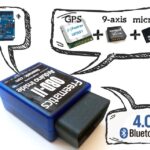Connecting an ESP8266 to your car’s OBD2 port opens up a world of possibilities for monitoring and customizing your vehicle’s data. This project focuses on using an ESP8266 to read specific data points from the car’s CAN bus and display them on a custom interface, bypassing the need for apps like Torque. We’ll delve into the challenges of translating Torque PIDs into raw CAN frames and explore how to decode this information for practical use.
From Torque PIDs to CAN Frames: Bridging the Gap
Many resources provide Torque PIDs for various vehicle parameters, including engine data, lighting, and tire pressure. However, understanding how these PIDs translate into actual CAN frames for direct communication with the vehicle’s system is often overlooked. This missing link is crucial for building custom solutions like displaying tire pressure on a separate ESP8266-driven display.
The core challenge lies in deciphering the relationship between the Torque PID definition and the structure of a CAN frame. A Torque PID typically includes information such as the PID ID, name, minimum and maximum values, scaling factor, unit, equation for converting raw data, and the CAN ID (header). But how do we extract the relevant bytes from the CAN message using this information?
Let’s analyze an example:
pid: 222A05 name: Tire 1 Pressure sName: T1Press Min: 0 Max: 50 Scale: x1 Unit: psi Equation: ((A 1373) / 1000) 0.145037738 Header: 720
This PID provides several clues. The “Header: 720” indicates the CAN ID in hexadecimal (0x720). The “Equation: ((A 1373) / 1000) 0.145037738″ reveals how the raw data (represented by “A”) is transformed into a meaningful pressure value in PSI. However, it doesn’t explicitly state which byte(s) within the CAN frame represent “A.” This is where deeper knowledge of the vehicle’s CAN protocol is necessary.
Decoding the CAN Frame Structure
To determine the structure of the CAN frame, we need to consult the vehicle’s CAN database (DBC file) or documentation. This file specifies the format of each CAN message, including:
- CAN ID: Already identified as 0x720 in our example.
- Data Length: The number of bytes in the data field of the CAN frame.
- Signal Layout: This crucial information defines which bytes correspond to specific signals (like tire pressure) and their data type (e.g., unsigned integer, floating-point). It also indicates the byte order (Big Endian or Little Endian) and bit position within the byte.
Once we have the signal layout from the DBC file, we can pinpoint the byte(s) containing the tire pressure data (“A” in the equation). We can then extract these bytes from the received CAN frame with the ID 0x720, apply the scaling and conversion specified in the Torque PID equation, and finally display the calculated PSI value on our custom display.
Conclusion
Successfully utilizing an ESP8266 for OBD2 data requires understanding the link between Torque PIDs and raw CAN frames. While Torque simplifies data access, decoding the underlying CAN structure is essential for customized solutions. By leveraging the vehicle’s CAN database and carefully analyzing the PID information, we can unlock the full potential of the ESP8266 for monitoring and interacting with our cars.

